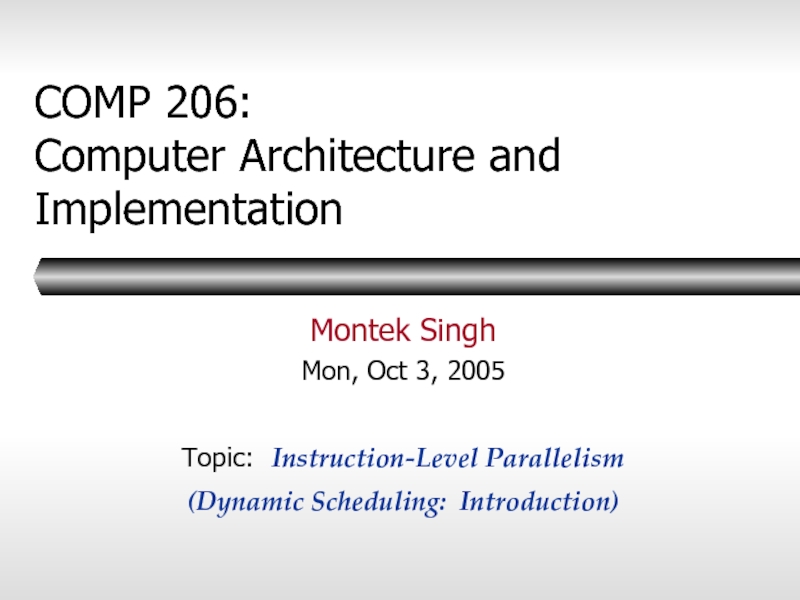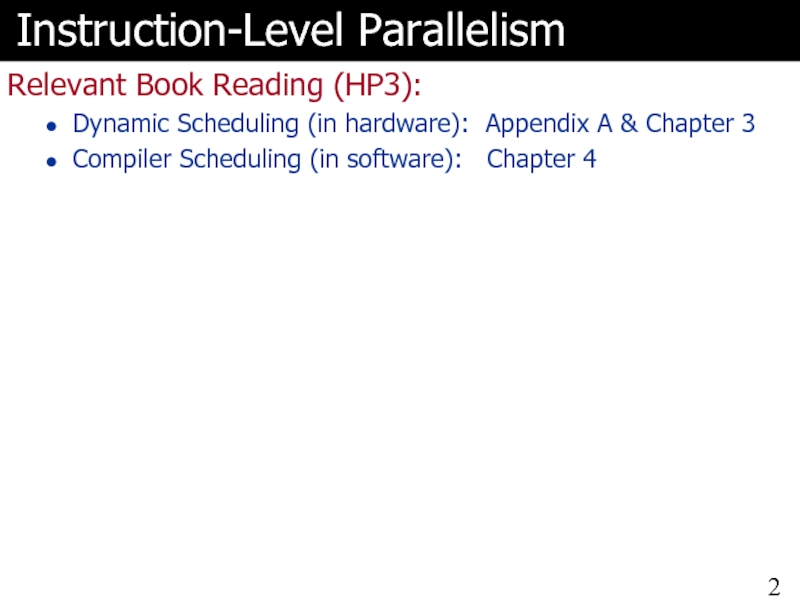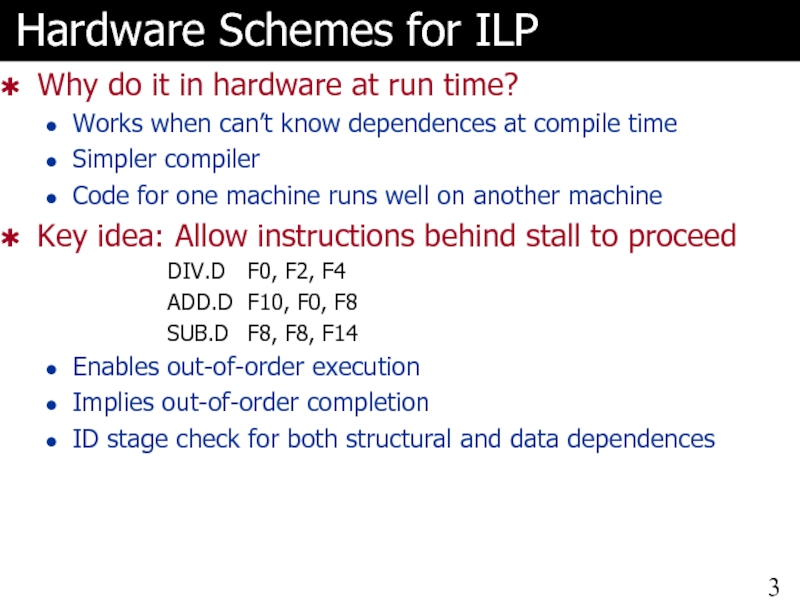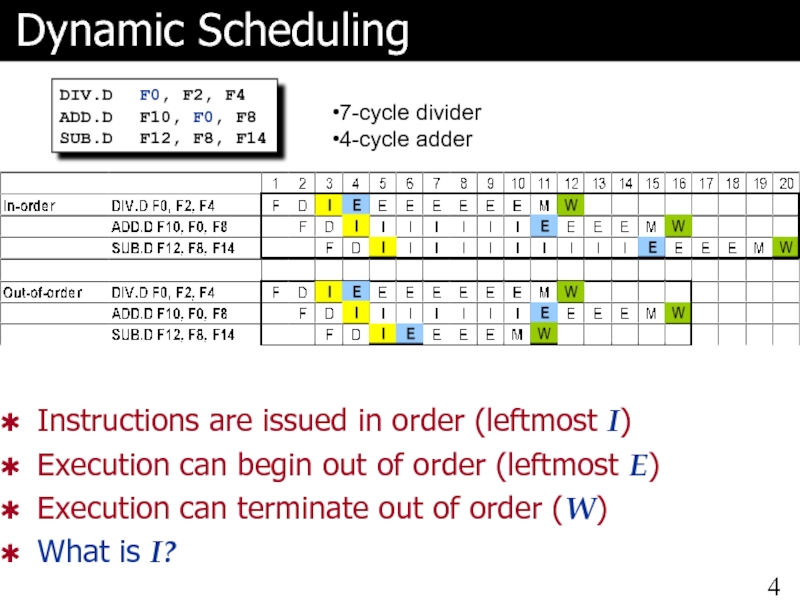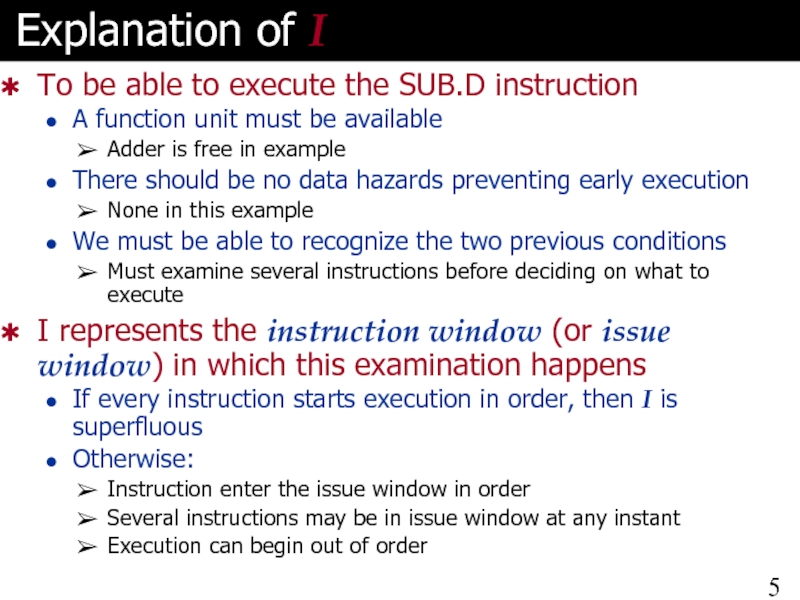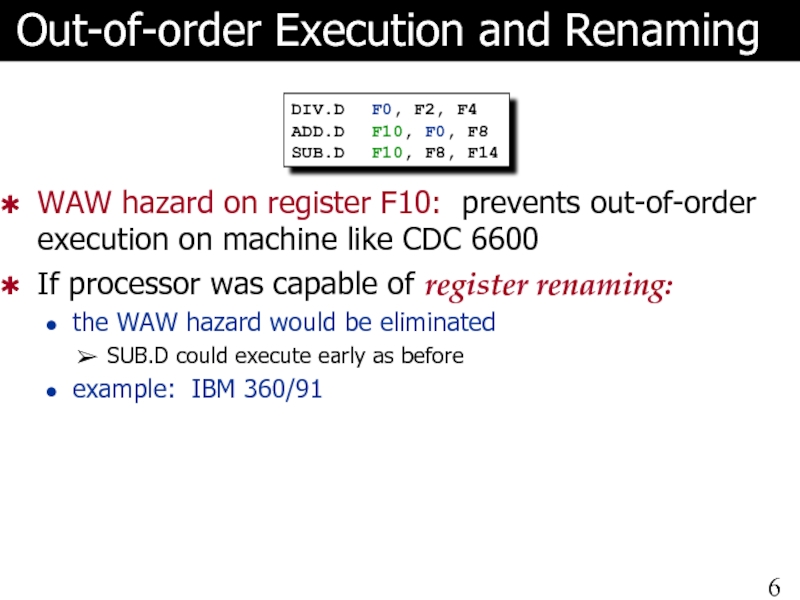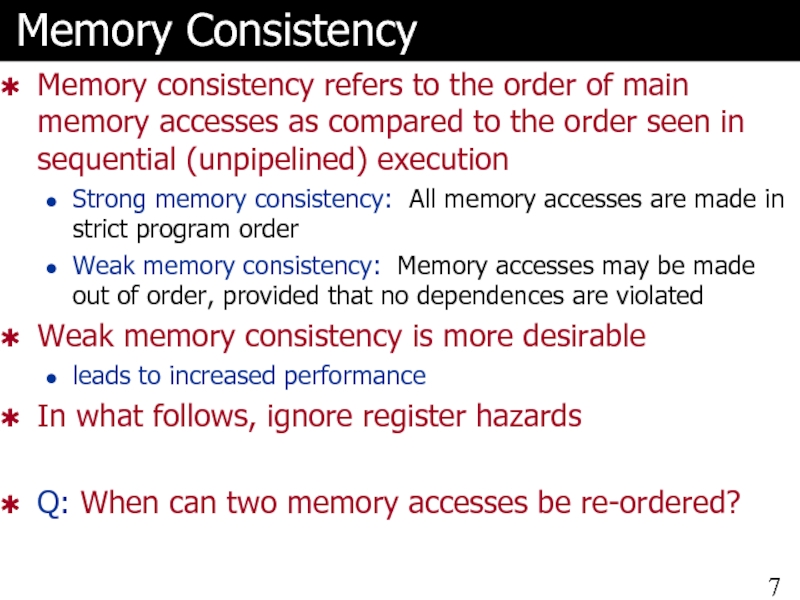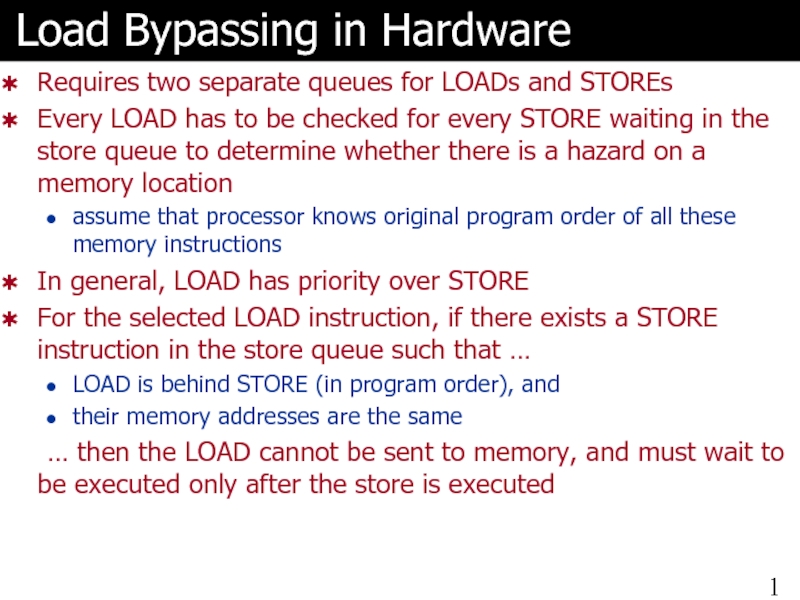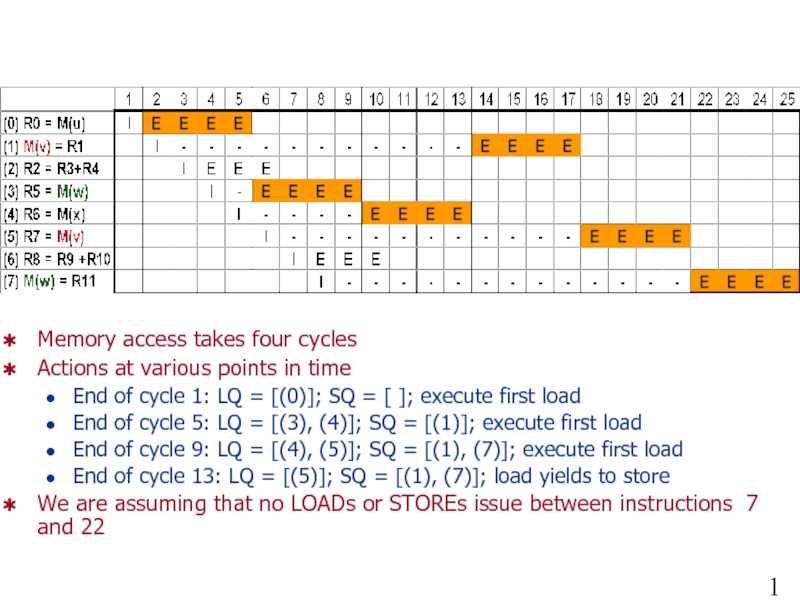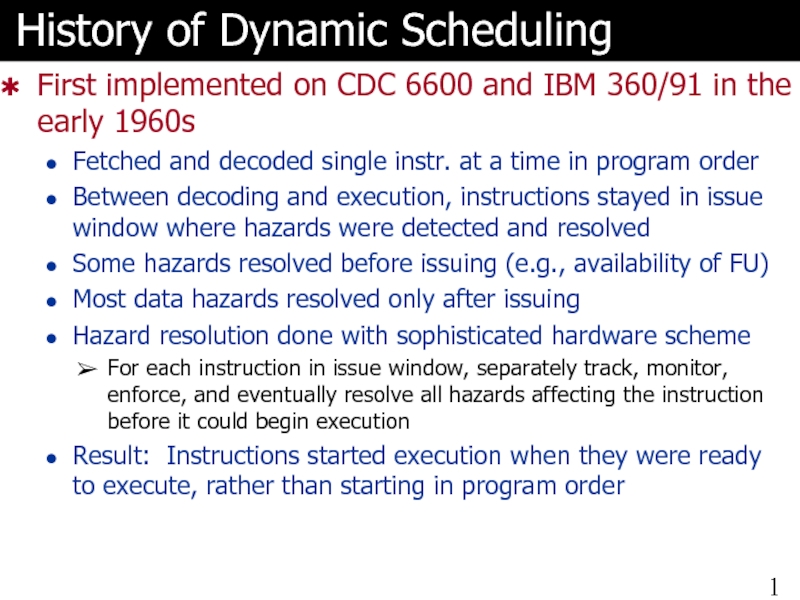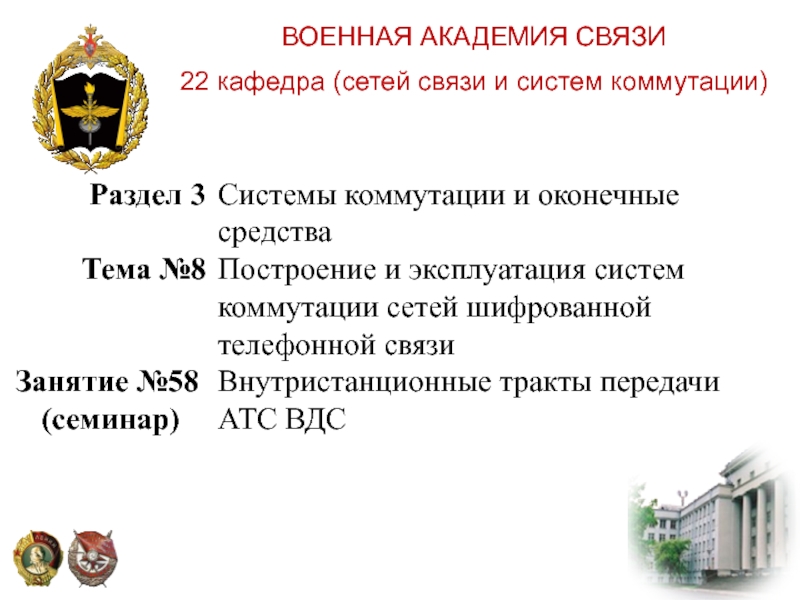Scheduling: Introduction)
- Главная
- Разное
- Дизайн
- Бизнес и предпринимательство
- Аналитика
- Образование
- Развлечения
- Красота и здоровье
- Финансы
- Государство
- Путешествия
- Спорт
- Недвижимость
- Армия
- Графика
- Культурология
- Еда и кулинария
- Лингвистика
- Английский язык
- Астрономия
- Алгебра
- Биология
- География
- Детские презентации
- Информатика
- История
- Литература
- Маркетинг
- Математика
- Медицина
- Менеджмент
- Музыка
- МХК
- Немецкий язык
- ОБЖ
- Обществознание
- Окружающий мир
- Педагогика
- Русский язык
- Технология
- Физика
- Философия
- Химия
- Шаблоны, картинки для презентаций
- Экология
- Экономика
- Юриспруденция
Computer Architecture and Implementation презентация
Содержание
- 1. Computer Architecture and Implementation
- 2. Instruction-Level Parallelism Relevant Book Reading (HP3):
- 3. Hardware Schemes for ILP Why do it
- 4. Dynamic Scheduling DIV.D F0, F2, F4 ADD.D F10, F0,
- 5. Explanation of I To be able to
- 6. Out-of-order Execution and Renaming WAW hazard on
- 7. Memory Consistency Memory consistency refers to the
- 8. Four Possibilities for Load/Store Motion Load-Load LW R1,
- 9. More on Load Bypassing and Forwarding Either
- 10. Load Bypassing in Hardware Requires two separate
- 11. Example of Load Bypassing Memory access takes
- 12. History of Dynamic Scheduling First implemented on
Слайд 1COMP 206:
Computer Architecture and Implementation
Montek Singh
Mon, Oct 3, 2005
Topic: Instruction-Level Parallelism
(Dynamic
Слайд 2Instruction-Level Parallelism
Relevant Book Reading (HP3):
Dynamic Scheduling (in hardware): Appendix A
& Chapter 3
Compiler Scheduling (in software): Chapter 4
Compiler Scheduling (in software): Chapter 4
Слайд 3Hardware Schemes for ILP
Why do it in hardware at run time?
Works
when can’t know dependences at compile time
Simpler compiler
Code for one machine runs well on another machine
Key idea: Allow instructions behind stall to proceed
DIV.D F0, F2, F4
ADD.D F10, F0, F8
SUB.D F8, F8, F14
Enables out-of-order execution
Implies out-of-order completion
ID stage check for both structural and data dependences
Simpler compiler
Code for one machine runs well on another machine
Key idea: Allow instructions behind stall to proceed
DIV.D F0, F2, F4
ADD.D F10, F0, F8
SUB.D F8, F8, F14
Enables out-of-order execution
Implies out-of-order completion
ID stage check for both structural and data dependences
Слайд 4Dynamic Scheduling
DIV.D F0, F2, F4
ADD.D F10, F0, F8
SUB.D F12, F8, F14
7-cycle divider
4-cycle adder
Instructions are
issued in order (leftmost I)
Execution can begin out of order (leftmost E)
Execution can terminate out of order (W)
What is I?
Execution can begin out of order (leftmost E)
Execution can terminate out of order (W)
What is I?
Слайд 5Explanation of I
To be able to execute the SUB.D instruction
A function
unit must be available
Adder is free in example
There should be no data hazards preventing early execution
None in this example
We must be able to recognize the two previous conditions
Must examine several instructions before deciding on what to execute
I represents the instruction window (or issue window) in which this examination happens
If every instruction starts execution in order, then I is superfluous
Otherwise:
Instruction enter the issue window in order
Several instructions may be in issue window at any instant
Execution can begin out of order
Adder is free in example
There should be no data hazards preventing early execution
None in this example
We must be able to recognize the two previous conditions
Must examine several instructions before deciding on what to execute
I represents the instruction window (or issue window) in which this examination happens
If every instruction starts execution in order, then I is superfluous
Otherwise:
Instruction enter the issue window in order
Several instructions may be in issue window at any instant
Execution can begin out of order
Слайд 6Out-of-order Execution and Renaming
WAW hazard on register F10: prevents out-of-order execution
on machine like CDC 6600
If processor was capable of register renaming:
the WAW hazard would be eliminated
SUB.D could execute early as before
example: IBM 360/91
If processor was capable of register renaming:
the WAW hazard would be eliminated
SUB.D could execute early as before
example: IBM 360/91
DIV.D F0, F2, F4
ADD.D F10, F0, F8
SUB.D F10, F8, F14
Слайд 7Memory Consistency
Memory consistency refers to the order of main memory accesses
as compared to the order seen in sequential (unpipelined) execution
Strong memory consistency: All memory accesses are made in strict program order
Weak memory consistency: Memory accesses may be made out of order, provided that no dependences are violated
Weak memory consistency is more desirable
leads to increased performance
In what follows, ignore register hazards
Q: When can two memory accesses be re-ordered?
Strong memory consistency: All memory accesses are made in strict program order
Weak memory consistency: Memory accesses may be made out of order, provided that no dependences are violated
Weak memory consistency is more desirable
leads to increased performance
In what follows, ignore register hazards
Q: When can two memory accesses be re-ordered?
Слайд 8Four Possibilities for Load/Store Motion
Load-Load
LW R1, (R2)
LW R3, (R4)
Load-Load can always be interchanged
(if no volatiles)
Load-Store and Store-Store are never interchanged
Store-Load is the only promising program transformation
Load is done earlier than planned, which can only help
Store is done later than planned, which should cause no harm
Two variants of transformation
If load is independent of store, we have load bypassing
If load is dependent on store through memory (e.g., (R1) == (R4)), we have load forwarding
Load-Store and Store-Store are never interchanged
Store-Load is the only promising program transformation
Load is done earlier than planned, which can only help
Store is done later than planned, which should cause no harm
Two variants of transformation
If load is independent of store, we have load bypassing
If load is dependent on store through memory (e.g., (R1) == (R4)), we have load forwarding
Load-Store
LW R1, (R2)
SW (R3), R4
Store-Store
SW R1, (R2)
SW R3, (R4)
Store-Load
SW (R1), R2
LW R3, (R4)
Слайд 9More on Load Bypassing and Forwarding
Either transformation can be performed at
compile time if the memory addresses are known, or at run-time if the necessary hardware capabilities are available
Compiler performs load bypassing in loop unrolling example (next lecture)
In general, if compiler is not sure, it should not do the transformation
Hardware is never “not sure”
Compiler performs load bypassing in loop unrolling example (next lecture)
In general, if compiler is not sure, it should not do the transformation
Hardware is never “not sure”
Слайд 10Load Bypassing in Hardware
Requires two separate queues for LOADs and STOREs
Every
LOAD has to be checked for every STORE waiting in the store queue to determine whether there is a hazard on a memory location
assume that processor knows original program order of all these memory instructions
In general, LOAD has priority over STORE
For the selected LOAD instruction, if there exists a STORE instruction in the store queue such that …
LOAD is behind STORE (in program order), and
their memory addresses are the same
… then the LOAD cannot be sent to memory, and must wait to be executed only after the store is executed
assume that processor knows original program order of all these memory instructions
In general, LOAD has priority over STORE
For the selected LOAD instruction, if there exists a STORE instruction in the store queue such that …
LOAD is behind STORE (in program order), and
their memory addresses are the same
… then the LOAD cannot be sent to memory, and must wait to be executed only after the store is executed
Слайд 11Example of Load Bypassing
Memory access takes four cycles
Actions at various points
in time
End of cycle 1: LQ = [(0)]; SQ = [ ]; execute first load
End of cycle 5: LQ = [(3), (4)]; SQ = [(1)]; execute first load
End of cycle 9: LQ = [(4), (5)]; SQ = [(1), (7)]; execute first load
End of cycle 13: LQ = [(5)]; SQ = [(1), (7)]; load yields to store
We are assuming that no LOADs or STOREs issue between instructions 7 and 22
End of cycle 1: LQ = [(0)]; SQ = [ ]; execute first load
End of cycle 5: LQ = [(3), (4)]; SQ = [(1)]; execute first load
End of cycle 9: LQ = [(4), (5)]; SQ = [(1), (7)]; execute first load
End of cycle 13: LQ = [(5)]; SQ = [(1), (7)]; load yields to store
We are assuming that no LOADs or STOREs issue between instructions 7 and 22
Слайд 12History of Dynamic Scheduling
First implemented on CDC 6600 and IBM 360/91
in the early 1960s
Fetched and decoded single instr. at a time in program order
Between decoding and execution, instructions stayed in issue window where hazards were detected and resolved
Some hazards resolved before issuing (e.g., availability of FU)
Most data hazards resolved only after issuing
Hazard resolution done with sophisticated hardware scheme
For each instruction in issue window, separately track, monitor, enforce, and eventually resolve all hazards affecting the instruction before it could begin execution
Result: Instructions started execution when they were ready to execute, rather than starting in program order
Fetched and decoded single instr. at a time in program order
Between decoding and execution, instructions stayed in issue window where hazards were detected and resolved
Some hazards resolved before issuing (e.g., availability of FU)
Most data hazards resolved only after issuing
Hazard resolution done with sophisticated hardware scheme
For each instruction in issue window, separately track, monitor, enforce, and eventually resolve all hazards affecting the instruction before it could begin execution
Result: Instructions started execution when they were ready to execute, rather than starting in program order
